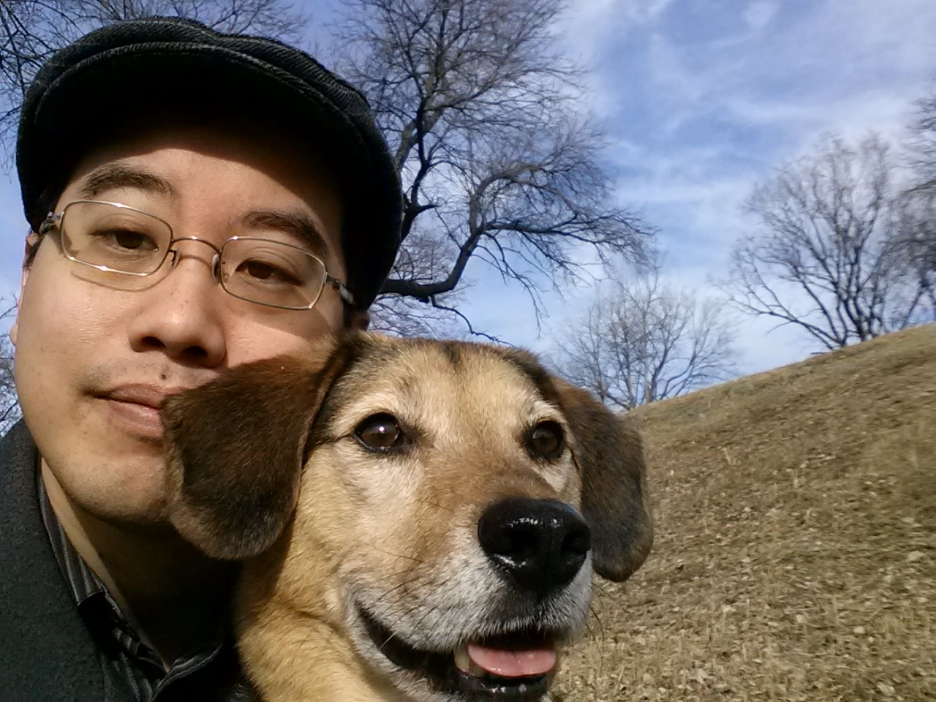My normal is dog.
I wasn’t always a dog person. A grad school friend likes to remind me, in fact, that I adamantly said I would prefer not to have her sister’s dog Storm visit our office. Oh, how quickly that all changed.
Growing up, my family only had goldfish as pets, and my only experiences with dogs were being chased by a neighborhood Labrador retriever and having a friend’s German shepherd leave teeth marks in my jacket. But during graduate school, there was a moment when suddenly many of my friends adopted dogs, and I found myself surrounded by them. With the encouragement of my partner, who had lived with two beloved dogs previously, we headed to the local animal shelter where we met and adopted Giles, a beaglish dog who wiggled his little body into our hearts and quickly reoriented my relationship with the world.

I had not the first clue about how to take care of a dog or how to live with a dog, and I was worried that the poor thing would not survive under my watch. It turns out, luckily, that dogs are very resilient and really just need the simplest of things—food, shelter, play and affection—to flourish as loving companions. We took Giles to puppy socialization and basic obedience classes, guided by a positive-reinforcement training philosophy, and found ourselves in the many social worlds of dog ownership. We took him to puppy play dates, dog parks and doggy day care. When we moved to the Twin Cities, we developed walking routines through our neighborhood. We learned which coffee shops and restaurants welcomed dogs on their patios. In all of these spaces, we encountered dogs and people we would never have met otherwise. We scripted our lives through Giles.
To say that my normal is dog is to say that I discovered how to negotiate social life through the constant presence of Giles. People’s relationships with dogs are manifold; they psychically and physically reshape spaces and behaviors in our homes and in public.
With a friend, I taught an honors seminar on how our relationships with dogs affect all kinds of interactions among humans, dogs and our built environment. For example, we thought about how debates over the establishment of dog parks sometimes were proxies for discussions of racial segregation and a history of dog-assisted police violence against black bodies. We considered how city ordinances for licensing dogs, leashing dogs in public and picking up dog waste all inform and are informed by norms of social behavior for both humans and dogs. We traced the presence of dogs in urban environments through fenced yards, signs about cleaning up after dogs and enclosed park spaces carved out for canines.
At the same time that Giles careened into my life, I was researching sounds in Asian American cultural productions. My intellectual orientation coalesced around Asian American studies and queer theory. This work, in general, critiques normative narratives of social life, race, gender and sexuality. Scholars in the field challenge received notions of who we should be and how we should act because these narratives weave uneven power through social institutions. For me, these two sides of my thinking life—dogs and social critique—were strongly connected because they offered examples of how to think outside mainstream narratives and particularly encouraged me to pay attention to the structures and institutions that codify power for certain people at the expense of others (both human and canine).
We put Giles to sleep in February 2016, a little over half a year after he was diagnosed with an inoperable bladder tumor. We were heartbroken. We grieved hard and continue to grieve. The house was suddenly so much emptier. We no longer had our companion there to greet us enthusiastically every time we came home. Our everyday activities shifted in unexpected ways. When we woke in the morning, we didn’t have to take care of the dog’s needs first. We took our meals without an animated and attentive audience. We could go to the basement without setting off a whirlwind of fur and barks. We stopped taking multiple daily walks.
We continue to light a candle for him every night.
In April, we brought another dog into our home and our lives. His name is Otis. He is his own unique creature, and we are learning who we all are anew in each other’s presence. We like to think that he and Giles would’ve been good friends to each other. Dog is my normal.
Resources
Dog books:
Doty, M. (2007). Dog years: A memoir. New York: HarperCollins Publishers.
Dunbar, I. (1996). How to teach a new dog old tricks: The Sirius puppy training manual. Berkeley, Calif: James & Kenneth Publishers.
Haraway, D. J. (2003). The companion species manifesto: Dogs, people, and significant otherness. Chicago: Prickly Paradigm Press.
Horowitz, A. (2009). Inside of a dog: What dogs see, smell, and know. New York: Scribner.
McConnell, P. B. (2002). The other end of the leash: Why we do what we do around dogs. New York: Ballantine Books.
Asian Americanist critique and queer theory books:
Butler, J. (2015). Gender trouble: Feminism and the subversion of identity. New York: Routledge.
Chuh, K. (2003). Imagine otherwise: On Asian Americanist critique. Durham: Duke University Press.
Lowe, L. (1996). Immigrant acts: On Asian American cultural politics. Durham: Duke University Press.
Matsuda, M. J. (1996). Where is your body?: And other essays on race, gender, and the law. Boston, MA: Beacon Press.
Nguyen, V. T. (2002). Race and resistance: Literature and politics in Asian America. New York: Oxford University Press.
Sedgwick, E. K. (2008). Epistemology of the closet. Berkeley, Calif: University of California Press.
Vaid, U. (1995). Virtual equality: The mainstreaming of gay and lesbian liberation. New York: Anchor Books.
Warner, M. (1999). The trouble with normal: Sex, politics, and the ethics of queer life. New York: Free Press.
Yoshino, K. (2006). Covering: The hidden assault on our civil rights. New York: Random House.

